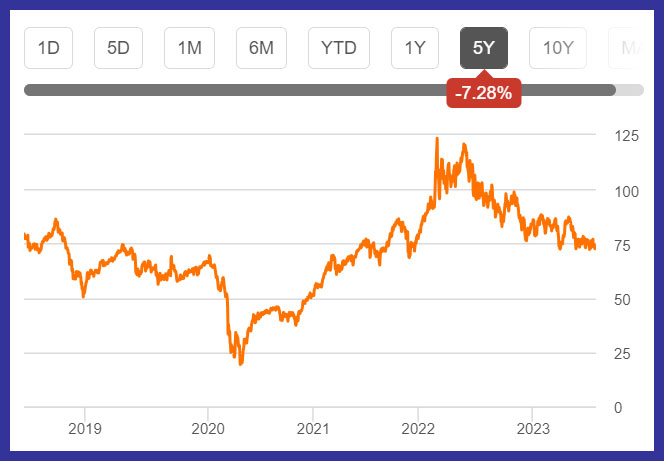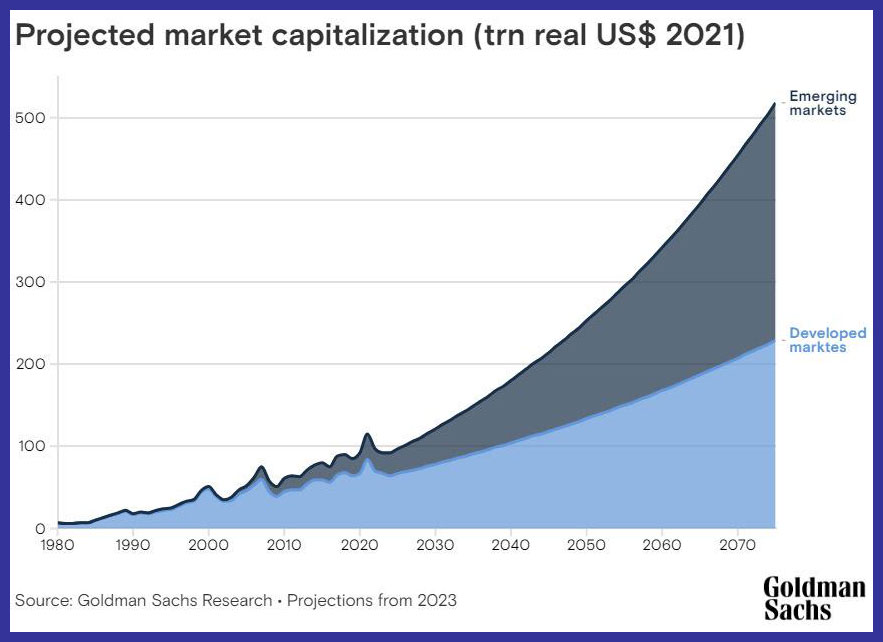Making sense of the markets this week: July 2, 2023
What’s up with inflation? Playing defence after the Russian near-coup, emerging markets set to emerge, Nike earnings and more.
Advertisement
What’s up with inflation? Playing defence after the Russian near-coup, emerging markets set to emerge, Nike earnings and more.

This week, Cut the Crap Investing founder Dale Roberts shares financial headlines and offers context for Canadian investors.
It’s no secret—with respect to stock markets, bond yields and the economy—inflation is still driving the bus. And the joke is that the central bankers are looking in the rearview mirror as they drive. They’re looking at data from the past, as the inflation bus hurtles forward.
Of course, the bankers want to see lower inflation in the target range of 2%.
Canada had a meaningful inflation report this past week. And perhaps we’ll give the inflation fight a grade of C-minus. Not great, but we’re moving in the right direction.
Today’s data: inflation! 📉🥳 https://t.co/6GZB1qIFQl
— Trevor Tombe (@trevortombe) June 27, 2023
The headline rate dropped to 3.4% in May (a large but expected decline). Big drops in Atlantic Canada. All now below 3%! #cdnecon pic.twitter.com/w5cVSgbNmO
Canada’s CPI was in line, at 3.4%. The slowdown was caused largely by lower year-over-year (YOY) prices for gasoline (-18.3%), resulting from a base-year effect (how the past 12 months have affected prices for the month). A spike in the previous year’s timeline will result in a lower reading a year later. Excluding gasoline, the CPI rose 4.4% in May, following a 4.9% increase in April.
From today’s inflation data, it looks like the entire increase in average prices of goods in Canada over the past year is due to groceries. And these are dropping (as expected). Good news! #cdnecon pic.twitter.com/FmNxcz05zi
— Trevor Tombe (@trevortombe) June 27, 2023
But, here’s the terrible irony: The fight against inflation is creating, yes, inflation. Mortgage-cost inflation due to higher rates was up 29.9% YOY. It is the largest contributor to inflation. Strip out that measure and inflation was up only 2.5% YOY.
While Canadian inflation continued to cool in May, that progress is unlikely to be enough to stop the Bank of Canada (BoC) from raising rates in July. Improvements in core inflation are slow, thanks to the services side, with inflation picking up in areas such as travel and restaurants. Less inflation for everyday consumer goods and staples is always welcome, but the BoC has likely been counting on that already as supply-chain issues continue to improve.
Canadians should not expect a reprieve on interest rates until 2024—at the earliest. For many months, I’ve been suggesting that inflation might stick between 3% to 4% and that high interest rates will be the norm for a while.
Let’s not forget the three inflationary waves of the stagnation era. Of course, we don’t know if history will repeat or rhyme.
Let’s see if history repeats itself…we are close to 1971 now pic.twitter.com/ijtXd3RWJt
— Inforlongs (@Inforlongs) June 29, 2023
The good news is that savers are being treated to some very generous rates for many savings accounts and guaranteed income certificates (GICs). I wouldn’t argue with a retiree who chooses to put three to five years of spending needs in high-interest savings and GICs.
Ultra short-term bonds are also delivering some very good yields. I was happy to see the launch of Horizons CBIL and UBIL.U (for U.S. accounts), which are both treasury bill ETFs and considered highly liquid. Horizons CBIL has a 4.23% target yield.
All in U.S. currency.
(GAAP stands for generally accepted accounting principles. Non-GAAP does not and doesn’t include items like non-recurring or non-cash expenses.)
Carnival saw continued acceleration of demand, with total bookings made during the quarter reaching a new all-time high for all future sailings. Booking volumes for the second quarter exceeded the first quarter’s booking volumes, which was the previous record high.
It also raised guidance for the next quarter for earnings and revenues.
I wrote about Harvest’s TRVL ETF in February 2022. One might have some solid gains if they had been dollar cost averaging into the ETF. It’s up 22.6% year-to-date. More to come? Or will recession fears wipe out any Summer fun?
Now onto Nike. Online sales continue to do it for Nike, and foreign currency is a drag. NIKE Direct reported revenues for the fourth quarter were USD$5.5 billion, up 15% compared to prior year and up 18% on a currency-neutral basis. Wholesale reported revenues for the fourth quarter were $6.7 billion, down 2% compared to prior year and up 2% on a currency-neutral basis.
Nike is a great company, but maybe not a great stock at this price (valuation). We hold Nike in my wife’s retirement account. The position was trimmed modestly near the all-time highs. That’s how you make income from growth stocks; they’re called homemade dividends. 😉
Consumer staples, though, continue to be very solid defensive holdings. Just look at McCormick and General Mills. For 2024, General Mills expects adjusted diluted earnings per share to increase 4% to 6% in constant currency.
Early in the morning on June 24, I wondered if we were watching one of the most important events of this century:
Watching history unfold? https://t.co/n6jhznbT4S
— CutTheCrapInvesting (@67Dodge) June 24, 2023
As you likely know by now, the Wagner Group (“private army for hire”) took a hiatus from operations in Ukraine and set its sights on Moscow. The world thought there was a coup in the making. It was feeling very 1917-ish, as when Czar Nicholas II was overthrown.
Turns out, we might have been watching some bad theatre with terrible actors and their poor acting. I joked the turnip was thanks to the writer’s strike in Hollywood; not to make light of the ego damage done to dictators or those who run private mercenary armies.
I’m just speculating, but coups normally end with the coup leader in power or dead, right? They don’t walk away and agree to go to a comfortable retirement in Belarus.
This weekend at the box office. 🎥🎬
— CutTheCrapInvesting (@67Dodge) June 26, 2023
“The Russian Coup” was a complete flop.
Those who cover the enertainment industry blame the writer’s strike. #RussiaCoup
We’ll find out soon enough what really happened, and if Russian President Vladimir Putin and Russian oligarch Yevgeny Prigozhin were in on this drama together.
This foreign affairs specialist has some interesting theories on the B-movie plot:
It was me who claimed that it was staged right from the beginning of the events while everyone was screaming coup. https://t.co/GoCmQR1zIO
— Velina Tchakarova (@vtchakarova) June 27, 2023
The coup demonstrated that political risk is ever present and these issues are part of human reality. In February of 2022, I wrote about wars and the impact on portfolios and asset classes. Looking back, my take on the effects of the invasion, and how assets would perform, was surprisingly accurate. More from my column:
“Brent crude topped USD$100 a barrel, and gold prices hit a one-year high, reaching USD$1,970 per ounce. Gold is up almost 9% from early January, while U.S. stocks (S&P 500) are down almost 12% into trading on February 24 [2023]. The tech-heavy Nasdaq slid into a bear market, now down more than 20% from recent peaks.”
Gold began to shine on the day of the recent coup, and then backed off, and it gilt did not feel the risks from this event.
On the history of oil and conflicts, CNN reports:
“Analysts at Rystad Energy said bouts of geopolitical uncertainty in major oil-producing nations over the past 35 years—ranging from civil unrest to coup attempts, armed conflicts and changes of governments—had on average added 8% to the price of oil in the five days after the triggering event.”
If Russia did tip into chaos, there’s a strong chance the world’s oil supply would be disrupted. And that would lead to an oil-price spike, due to the invasion of Ukraine, similar to that of 2021 and 2022.
A look at Brent crude:

Russia is also a nuclear powerhouse, so the threat of an accident or attack is elevated. That might be the ultimate risk, and it would be unprecedented. It’s likely the price of gold would spike, and bond prices would also move substantially higher as investors seek safety. Many investors are looking at defensive stocks, as I wrote about on cutthecrapinvesting.com.
While the nuclear threat is largely dismissed by most observers, anything is possible.
As a semi-retiree, I’m happy to hold my version of an all-weather portfolio. I might be ready for most anything, even the fallout from a failed coup, or whatever the heck that was.
As Wayne Gretzky famously said: “I skate to where the puck is going to be, not where it has been.” Some Canadians subscribe to this quote as an investing theory, and are starting to consider some more portfolio exposure to emerging markets (EM). While out of favour in recent months and even years, there are many recent projections that emerging markets will provide much of the needed portfolio growth over the next half century.
The below stats and graph are courtesy of the Grit email, to which I subscribe.
Goldman Sachs expects EM stock capitalization to become larger than that of the United States by 2030.

International markets, especially emerging markets, are greatly overlooked by Canadian self-directed investors. I discussed the potential of emerging markets back in November 2020. In that column, I pulled the below quote from Forstrong Global president and CIO Tyler Mordy:
“Today many investors are experiencing their own existential struggle with emerging Asia’s economic rise. On the one hand, the region — which we classify as China, India, Taiwan, Korea, Indonesia, Malaysia, Philippines, Thailand and Vietnam — has created enormous growth around the world. China alone has delivered roughly half of all global GDP growth over the last decade. This has been a crucial prop to a growth-deficient world.”
Chinese Premier Li Qiang says China is on track for an annual 5% growth rate. CNN reports: “China’s Premier Li Qiang struck an upbeat tone about the world’s second largest economy on Tuesday, telling a gathering of global financial elites that growth in the current quarter will be higher than it was in the first three months of the year.”
Premier Qiang said: “We are on track to achieve the annual growth target of ‘around 5%’ that we set earlier this year.”
And India’s stock market is hitting new highs:
Canada’s CPI (ex-gas) is at 4.4% YoY in May which is down -2.2 ppts since Dec 2022 (which was the peak).
— MTS Insights (@MTSInsights) June 27, 2023
This is also the lowest since Jan 2022. Core CPI is even lower at 4.0% YoY after removing the effects of food prices.
The Bank of Canada may have been quick to hawkishly… pic.twitter.com/dY3X9kdrUZ
Given the potential emerging markets growth over developing markets, in the advanced couch potato portfolios, I looked at an equal weighting for international exposure. Check out MoneySense ETF all-stars, which includes a few EM ideas, including iShares Core MSCI EAFE IMI Index ETF (XEF).
Growth may be scarce in the future, and it might be on the other side of the planet.
And as I noticed on my blog, the balanced portfolio is making a comeback after a dismal 2022.
Remember the “death of the 60/40 portfolio”?
— Nate Geraci (@NateGeraci) June 29, 2023
Yeah, I remember that. pic.twitter.com/vbLSlXKlfT
Share this article Share on Facebook Share on Twitter Share on Linkedin Share on Reddit Share on Email